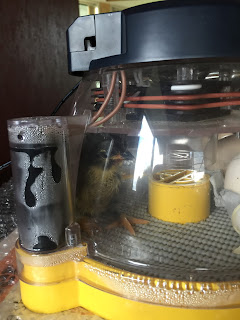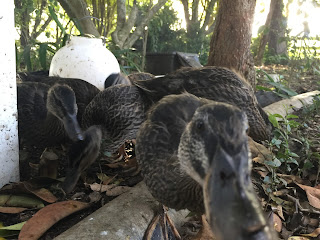Or, if you are me, read and re read what to expect from day 18 onwards and check obsessively to see whether anything is pipping yet.
Your eggs should hatch day 21, but i wasn't sure whether that meant they would pip on day 21 or whether they should be hatched by then. It doesn't help that they could hatch earlier or later than that. Hatching day 19 probably means your incubator was running a bit hot, or maybe that the eggs had been at correct temperatures to start before you set them.
Haching days later could mean your incubator was a bit cooler than it should be, I found many people who stated they had eggs hatch as late as day 28, but anything that came out really late had issues.
You could candle I guess, there seems to be as many people online who will tell you it's okay to open the incubator whenever, they hatched eggs in their hands and let their friends hold eggs while exhausted chicks pushed the remaining eggs shell of their tiny heads,
as there are people who tell you don't touch the eggs or open the incubator! your tiny chick has spent days trying to get into the correct position to find it's air cell. If you screw it up for them they can pip in the wrong place and drown or hit a vein and bleed out. Removing the cover of your incubator will screw up all the humidity you are trying to keep high enough that the membrane will be ideal for them to break out of it.
We didn't open ours, even though I wanted to. It's possible people who open their incubators whenever they want, live in places where the humidity is high enough that it won't affect their hatching chicks. I didn't want to hurt their chances of finding the air cell. If they didn't get further than this stage, I didn't want it to be because I just couldn't wait.
At the end of day 20 we got our first external pip.
Egg 7 had pipped into the air cell, taken their first breaths and then broken a tiny hole through the shell, yay! I knew it could take about 24 hours from now if it even did hatch, the chick needs to absorb it's blood supply and yolk. It needs to rest and breathe and eventually start using it's egg tooth, legs and neck muscles to zip around the egg shell, breaking pieces off in a line the entire way around so it can get out.
It didn't go any further that night and had maybe made its' pip hole a tiny bit bigger by the time I left for work friday morning, neither had the others.
I got a call at work about 11am from Miss A,
I got a call at work about 11am from Miss A,
'Guess what, we have a chick! and it's not who you think it is!'
Egg 10, in record time had pipped and zipped and somehow heaved himself out of his vertically positioned egg.
He was damp and exhausted, peeping and flopping around.
Hatching is hard work!
By the time I got home from work he was much fluffier and energetic. He'd do what I called a crazy circuit, sleep by egg 10, peep, frantically squish himself over egg 9, sleep by egg 1, crash into egg 10 and sleep again.
Chicks can survive for (i think) about 36 hours off their absorbed egg yolk. He didn't need to come out yet. I didn't want to upset the incubator humidity. Some people will remove their chicks as they hatch, it stops them playing chicken football with their hatching friends. Some will leave them all until they have hatched and say chicken football encourages the remaining chicks to hatch.
We only had 4 eggs in the Brinsea, you an fit 7, it could be that Orpingtons lay big eggs and the chicks are large, but I really can't imagine having 7 hatching chicks in here.
Egg 7 peeped and slowly worked on her pip hole, chipping away, sleeping, peeping, all while being knocked about and slep on by number 10.
Egg 7 peeped and slowly worked on her pip hole, chipping away, sleeping, peeping, all while being knocked about and slep on by number 10.
It took almost 23 hours before anything much else happened. All of a sudden there was a line of broken shell, working counter clockwise she quickly chipped away at her egg prison.
It only took a few minutes and she was out!
She laid on the floor, panting and wet and so tired!
Number 10 raced all over the place.
I realised watching this video that egg 1 had already pipped too, you can see her little beak poking out through her pip hole.
She started about 6pm and decided to do things a bit differently.
As number 10 and 7 threw themselves around, number 1 decided to just push her hole face through her pip hole.
Oh well, she can breathe I thought, she should be fine.
I went to bed with 2 and a half hatched chicks in the Brinsea. Nothing happening in the Rotohatch although that was expected.
On Saturday morning number 7 and number 10 went to their waiting brooder box to leave number 1 to finish hatching in peace.
And she did! she got to stay in a bit longer to fluff up.
The brooder box is the same one we used for the wild ducks, cleaned and disinfected. We divided it in half with a cardboard wall and put down a layer of paper towels for the first 4 days, food was sprinkled on the paper towels while the chicks learn what is food and hopefully they will eat that and not the wood shavings.
I had though egg 9 had a good chance and egg 12 was a possible hatch. We moved 12 into the Brinsea and decided to give them a few more days. We removed and opened egg 11, this chick had quit before day 18.
Just after day 21 we had 3 happy healthy nuggets! all look good, absorbed everything, good eyes, legs and feet, no bum issues. They slept under the ecoglow, nibbled their started crumbs and got used to drinking water on their little wobbly legs

















































